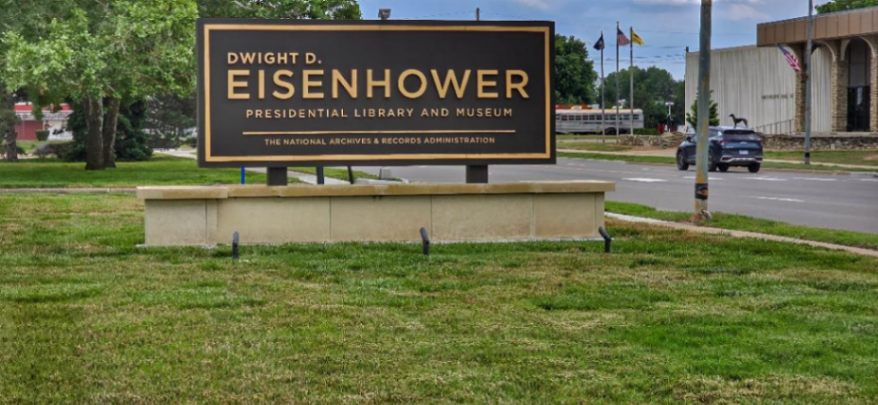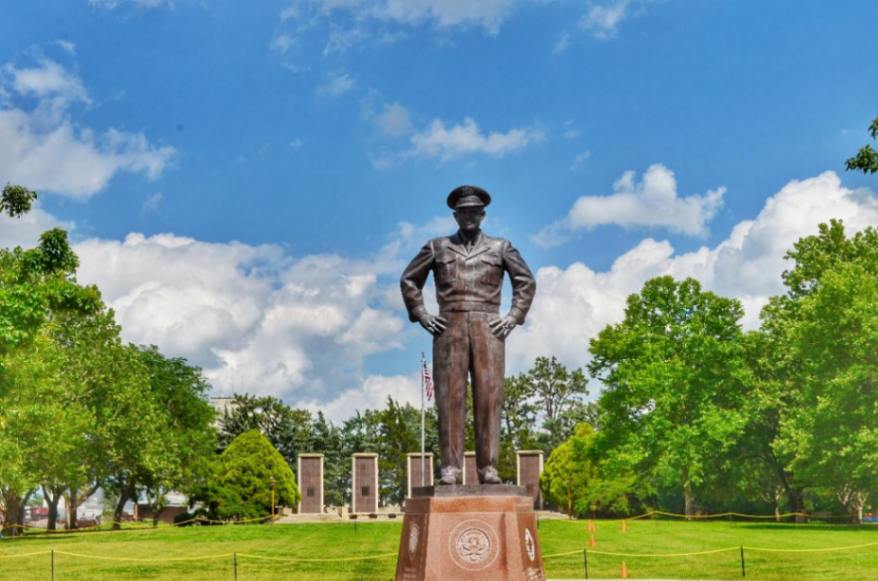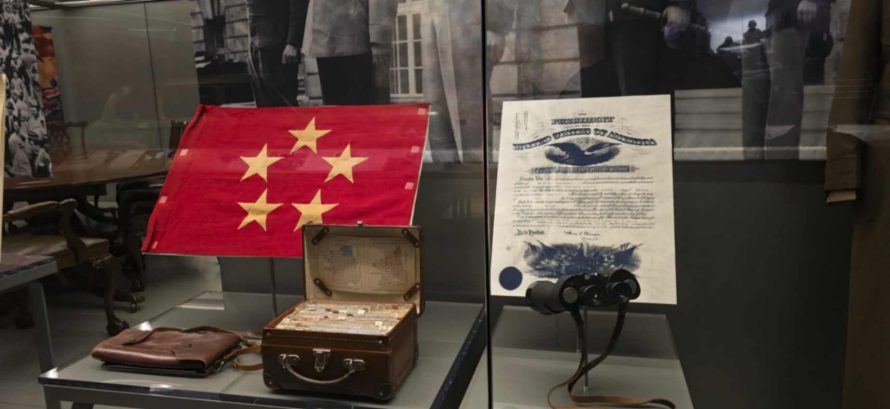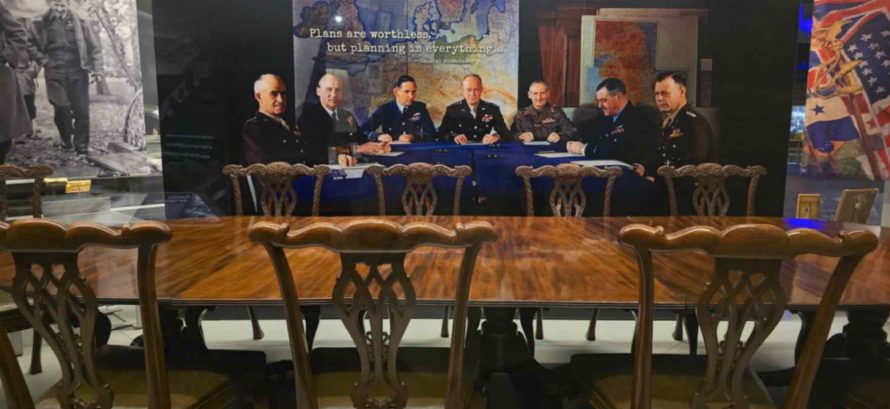My trip to Abilene Kansas was hosted by Visit Abilene

Depending on how you count it, there are either 16 or 17 Presidential libraries. President Gerald Ford has a split library with the library located in Ann Arbor Michigan and the museum located in Grand Rapids Michigan. I have only visited four of the Presidential libraries but there are many that make traveling to and visiting Presidential libraries a bucket list goal.
One of the best I have visited was the Eisenhower Presidential Library and Museum in Abilene Kansas. Being retired military, and a history buff, this library checked off a lot of things I am interested in. President Dwight D Eisenhower was known as the Soldier President had a remarkable life.
Graduating from West Point in 1915, Eisenhower achieved the rank of 5-star General. Along the way, in Eisenhower’s early army career, he excelled in staff assignments, serving under Generals John J. Pershing and Douglas MacArthur. He wrote a guidebook to World War I battlefields, which would serve him later in knowing the lay of the land during WW2. After Pearl Harbor, General George C. Marshall called him to Washington to work on war plans. He commanded the Allied Forces landing in North Africa in November 1942; on D-Day, 1944, he was supreme commander of the troops invading France.

After the war in 1948 Eisenhower was inaugurated as President, Columbia University, New York City. In December of 1950 Eisenhower was named the first Supreme Allied Commander, North Atlantic Treaty Organization (NATO), and given operational command of US Forces Europe. He retired from active duty and resigned his commission in July 1952, marking 41 years since he first entered West Point, so he could run for the Presidency.
After his term ended as President his successor, President Kennedy reactivated his commission as a five-star general, General of the Army, making Eisenhower the only United States President with military service to reenter the Armed Forces, except Washington, after leaving the office of President.
After leaving the White House, the Eisenhower’s went to live at their farm in Gettysburg, Pennsylvania. Purchased in 1950, it was the only home they ever owned. When Eisenhower died, in 1969, his body was placed in a standard issue soldiers coffin, per his instructions.
Early Life & Kansas Roots
Birth and Childhood
Born David Dwight Eisenhower on October 14, 1890, in Denison, Texas, Ike was the third of seven brothers in a working-class family. His parents quickly reversed his names to avoid confusion with an older sibling, choosing the nickname “Ike” for all the boys. In 1892, the family relocated to Abilene, Kansas, where Ike would grow up and later call home.

Growing Up in Abilene
Abilene was a frontier Cowtown at the end of the Chisholm Trail. Young Ike soaked in the history—reading Westerns, admiring legends like Wild Bill Hickok, and building a lifelong love of the past. He excelled at sports, boxed, hunted, and played poker with town characters, sharpening observation and calculation skills that would later define his leadership style.
He worked hard—selling produce, delivering ice, harvesting crops, and serving overnight shifts at a creamery to help fund his brother’s college so that he could later attend West Point, where he enrolled in 1911. His hometown values of self-reliance, fairness, and integrity shaped a leader who would later command generals and serve two terms as president.
Military Career: From West Point to D-Day
Rising Through the Ranks
Eisenhower’s formative years were marked by practicality rather than grand ambition. Initially, he hoped to attend the University of Michigan on a football scholarship, but financial limitations redirected him. In 1911, at age 20, he secured an appointment to the United States Military Academy at West Point through the influence of a friend and Congressman Charles Curtis. His West Point tenure (1911–1915) was challenging; a knee injury ended his football aspirations, and he graduated 61st in a class of 164. Commissioned as a second lieutenant, he married Mamie Geneva Doud on July 1, 1916, in Denver, Colorado. The couple had two sons: Doud Dwight, who died of scarlet fever in 1921 at age three, and John Sheldon Doud, born in 1922.
Eisenhower’s military career began with modest postings, including Fort Sam Houston, Texas, where he met Mamie. During World War I, he trained tank crews at Fort Oglethorpe, Georgia, missing combat but earning recognition for his organizational skills. Post-war, he served under General John J. Pershing and later General Douglas MacArthur, including a significant posting in the Philippines (1935–1939) as MacArthur’s chief military advisor, where he helped modernize the Philippine army. In 1927, under the direction of General Pershing, Eisenhower was dispatched to Europe to write a guidebook to World War I battlefields for American Battle Monuments Commission. This afforded him the opportunity to study battlefields and the terrain which would later enable him to effectively plan battle movements during WW2.

World War II Command
In 1941 he oversaw military maneuvers in Louisiana that caught the attention of Army Chief of Staff George Marshall, earning him promotion to planning roles in Europe. Ike rose to become Supreme Allied Commander in Europe, orchestrating the massive D‑Day invasion in June 1944 and coordinating Allied forces until V‑E Day. His calm decisiveness and consensus-building earned global respect, along with the rank of Five‑Star General.
The Road to the Presidency & Achievements in Office
From General to Candidate
After the war, Eisenhower served as Army Chief of Staff (1945–1948), overseeing demobilization, and later as president of Columbia University (1948–1950), though he found academia less fulfilling. His national stature grew, prompting political overtures. Reluctant at first, he announced his candidacy for the Republican presidential nomination on June 4, 1952, in Abilene, motivated by a desire to counter isolationism and unify the nation during the Cold War. He defeated Adlai Stevenson in a landslide on November 4, 1952, becoming president on January 20, 1953.

Major Presidential Accomplishments
Eisenhower’s presidency (1953–1961) was marked by significant achievements. He negotiated the Korean War armistice in 1953, ending a divisive conflict. His “Atoms for Peace” speech in 1953 promoted nuclear energy for peaceful use, easing Cold War tensions. He navigated crises in Lebanon (1958), Suez (1956), Berlin, and Hungary (1956) with diplomacy, while maintaining military readiness. Domestically, he authorized the Interstate Highway System in 1956, a transformative infrastructure project. He signed the 1957 Civil Rights Act, the first since Reconstruction, and sent federal troops to integrate Little Rock Central High School in 1957. Other milestones include statehood for Alaska and Hawaii (1959), the creation of NASA (1958), and the U.S. Information Agency to counter Soviet propaganda. In his Farewell Address on January 17, 1961, he warned of the “military-industrial complex,” a lasting critique. After leaving office, he retired to Gettysburg, Pennsylvania. In 1961, after leaving office, President Kennedy reinstated Eisenhower’s commission and returned him to the rank of 5-star General of the Army. During his retirement he stayed busy writing his memoirs and advising presidents until his death on March 28, 1969, at age 78. He was buried with Mamie and Doud in the Place of Meditation at the Abilene library.
Eisenhower’s presidency is remembered as a period of cautious reform, peace, and prudent economic stewardship—an era he described as “a soldier of peace”.
The Presidential Library: Creation & Campus
Origins and Construction

In 1958, construction began on the presidential library, making it one of the few built before a presidency ended. The cornerstone was laid in October 1959, with Eisenhower present. The library was dedicated on May 1, 1962, with Vice President Lyndon Johnson in attendance. In 1966, the National Archives (NARA) took over operations, making this the fourth presidential library in the system.
Campus Facilities
The 22‑acre campus includes five buildings:
- Library: A research facility housing more than 30 million pages of records, 335,000 photographs, 70,000 artifacts, and original film and audio holdings. Open to researchers by appointment it contains original documents, photos and videos.
- Museum: A limestone building completed in 1954, later restored in 1971, with five galleries focusing on Ike’s life, military career, presidency, and Mamie’s role. A major renovation in 2019 added 25,000 ft² of interactive exhibit space, featuring immersive displays like “Becoming Ike and Mamie” and Cold War simulations
- Visitors Center: Located at Ike’s old elementary school site, offering a film theater and gift shop
- Boyhood Home: The house Ike lived in from 1898 until he left for West Point. Opened in 1947, furnished in 1946-era decor, and built onto over time as the family grew. Admission is via guided tours limited to small groups to preserve authenticity
- Place of Meditation: A modern chapel dedicated in 1966, built of Kansas limestone, and housing the graves of Dwight, Mamie, and their son Doud Eisenhower. It’s a quiet, reflective space with stained glass and a minimalist design intended for contemplation.
Additional features:
- A bronze statue of Eisenhower by Robert L. Dean Jr., located near the visitor center in a circle of patriotic paving stones and granite pylons inscribed with his life milestones and family legacy.

What to See & Visitor Highlights
Museum Galleries
- “Becoming Ike and Mamie” interactive exhibit tracing early years through pre-WWII assignments
- D‑Day and Supreme Commander galleries with artifacts, strategy maps, and personal gear
- Cold War exhibits covering Ike’s policy decisions, footage, and presidential addresses
- First Lady gallery highlighting Mamie Eisenhower’s style, domestic influences, and public life
- Rotating exhibits like “We the People”, featuring veteran portraits from across America
Boyhood Home Tour
Restored to its original turn-of-century state, the six-room home includes period wallpaper, furniture, and even the original layout—evoking daily life in small-town Kansas. Highlights include the upstairs bedrooms added in early 1900s and the kitchen-garden landscape Ike worked in as a youth.
Place of Meditation & Grounds

Find personal peace at Ike’s gravesite—where he and Mamie lie alongside young son Doud. The chapel’s tranquil architecture and glass windows offer a serene counterpoint to the history displayed elsewhere. Pylons and the bronze statue nearby provide context and static artful reminders of his values and journey.
Library & Research Archives
For scholars or history lovers: the research room holds vast collections—papers from Eisenhower and over 400 of his associates, plus personal letters and strategic documents. Temporary exhibits in the library gallery showcase rarely seen archival materials to the public. However, access to the research library is by appointment only. It is open to everyone but you must get approval first, so plan ahead if you want to look over some amazing original documents and photos.
Planning Your Visit
- Hours: Campus buildings open Tues–Sat (9 a.m.–4:30 p.m.), Sundays shorter; library research room requires appointment; grounds open sunrise to sunset
- Tickets: Purchase in person or online. Boyhood home tours limited to 10 people, tickets sold onsite only
Why This Site Matters
- Early Library Precedent: One of only two presidential libraries begun before the end of the presidency, pioneered by Ike himself
- Comprehensive Archives: Over 30 million pages of documents, nearly a million photographs, film, audio, and artifacts
- Cultural and Historical Context: From boyhood Kansas to Supreme Allied Commander to President—everything is on‐site in one accessible, emotionally resonant campus
- Visitor Experience: Engaging interactive exhibits and preserved home life, making history tangible for all ages.
Final Reflections
A visit to the Eisenhower Presidential Library in Abilene, Kansas, is more than museum tourism—it’s a journey through 20th-century America, seen through the life of a leader who helped shape modern history. From his humble roots in a six-room clapboard house to global command and presidential power, Dwight D. Eisenhower’s story is anchored in a place that honors both his legacy and the small-town values he carried throughout his life.
This presidential site is a pilgrimage for history lovers, veterans, scholars, and curious travelers alike. The Eisenhower Presidential Library and Museum is a living testament to a man who shaped modern America. and where a self-made boy from Abilene became a soldier, statesman, and visionary.


Leave a Reply